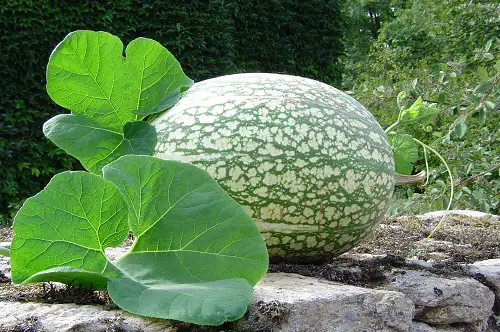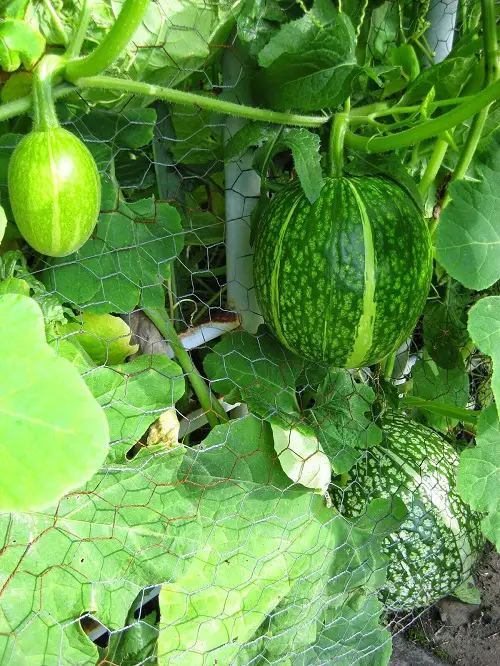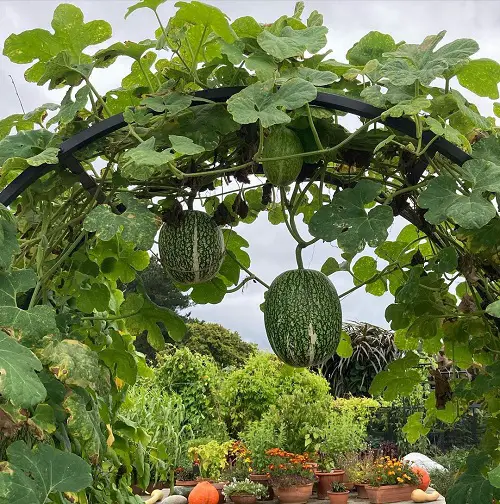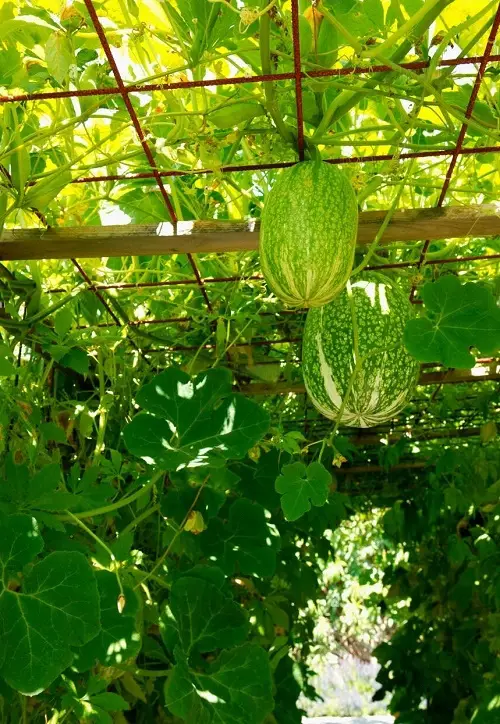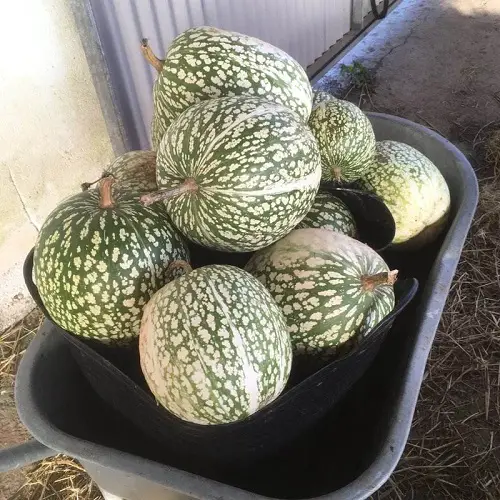Learn How to Grow Chilacayote Squash in easy steps. Whether you’re a seasoned gardener or a beginner, these tips will help you!
Growing Chilacayote Squash is a great way to add a unique and delicious vegetable to your garden. By following the given steps, you can grow healthy and productive plants and enjoy a bountiful harvest!
Common Names: Asian pumpkin, black seed squash, chilacayote, cidra, fig-leaf gourd, and Malabar gourd
Botanical Name: Cucurbita ficifolia
Learn How to Grow Squash on a Trellis
Chilacayote Squash Information
Chilacayote is a type of squash that is native to Mexico and Central America. It is a fast-growing vine that produces elongated, oblong fruit similar to a watermelon, with a rough, dark brown stem and a smooth, firm rind that ranges in color from light green to dark green. The rind is mottled with cream-colored spots and occasional streaks running the length of the fruit.
The young, small squash is entirely edible, with thin and tender skin, flesh, and seeds. However, as the squash matures, the rind becomes very hard and inedible. Its flesh is bright white with a spongy, moist texture and encases many flat, black to dark brown seeds, with each squash containing a varying number of seeds, some up to five hundred.
When cooked, Chilacayote squash has a mild, neutral taste and easily absorbs the flavors of other ingredients.
Propagating Chilacayote Squash
Chilacayote squash can be propagated by planting the seeds directly in the soil. It is best to wait until warm weather has arrived before planting the seeds. Use well-draining soil and till it lightly before planting.
- Seeds should be planted 1-2 inches deep and spaced 4-6 inches apart.
- Water gently and regularly until the plants are established.
- Once plants have reached a height of 6-8 inches, they can be thinned to 12-18 inches apart.
Learn about the best squash varieties
Growing Chilacayote Squash in Pots
Chilacayote squash requires a large pot for successful growth. Choose one that is at least 12 inches deep and 20 inches wide. Be sure the pot has drainage holes at the bottom.
Requirements for Growing Chilacayote Squash
Sunlight
Chilacayote squash is a tropical vine that thrives in full sun. It prefers at least 7-8 hours of direct sunlight per day to grow and produce its large, round, green-striped squash.
The plant can tolerate some shade, but full sun is the best for optimal growth and production.
Soil
The soil should be slightly acidic, with a pH between 6.0 and 6.5. The growing medium should also be high in organic matter, such as compost or aged manure, to ensure adequate nutrient levels.
Water
The plant does not require a great deal of water, but it does need some in order to produce good yields. Water it deeply but infrequently, allowing the soil to dry out between waterings.
During the growing season, water it 1-2 times per week, depending on the climate and soil type. Water at the base of the plant, avoiding the leaves, to prevent fungal diseases.
During the hottest part of summer, you may need to water the plant more frequently.
Chilacayote Squash Care
Fertilizer
When growing squash, fertilizing is important for ensuring healthy and productive plants. Use a balanced liquid fertilizer like a 10-10-10 or 5-10-10 blend.
It is best to apply the fertilizer when the plants are actively growing and producing new leaves, usually when they are about 6 inches tall.
Apply the fertilizer around the base of the plant and water it in. Apply every two to three weeks throughout the growing season.
Support
Trellis is a great way to support the growth of squash. It helps keep the fruit off the ground, allowing for better air circulation and prevention of disease and pests.
It also provides the structure needed for the vines to climb and helps to maximize space in your garden. To build a trellis, use four posts and some netting or twine strung between them. Make sure the posts are securely in the ground and the netting is tight.
Plant your squash near the base of the trellis and train the vines to climb as they grow. Prune the vines regularly and tie them in place as needed.
Have a look at the best squash trellis ideas
Pests and Diseases
- Squash Vine Borers: These pests burrow into squash stems and feed on the inner tissue. To prevent them, cover the base of the plants with row covers, keep the area around the plants free of weeds and debris, and use mulch or plastic to keep the stems dry and cool.
- Powdery Mildew: This fungal disease is caused by high humidity and poor air circulation. To prevent it, water the plants at the base of the plant and not on the leaves, provide adequate space between plants, and prune away any dead or infected leaves.
- Cucumber Beetles: These pests feed on the leaves and flowers of squash plants. To prevent them, use row covers to keep the beetles away, handpick them off the plants, and use traps or insecticides as a last resort.
- Squash Bugs: These pests suck the sap from the leaves of squash plants. To prevent them, keep the area around the plants free of weeds and debris, handpick the bugs off them, and use insecticides as a last resort.
- Bacterial Wilt: This is a bacterial disease caused by a soil-borne pathogen. To prevent it, practice crop rotation, avoid planting in wet or poorly drained soil, and use disease-resistant varieties.
Harvesting Chilacayote Squash
- Chilacayote squash will be bright green and will have a few yellow patches when ready to be picked.
- Gently twist and pull the squash from the vine. If it does not come off easily, it is not yet ripe and should be left for a few more days.
- Place the squash in a safe place away from direct sunlight. This will help the squash to last longer and retain its flavor.
- Cut the stem off the squash and discard.
- Store the squash in a cool and dry place. It should last for up to a month when stored properly.
Learn about the different names of squash in different languages
Chilacayote Squash Uses
Chilacayote squash is a versatile vegetable that can be used in a variety of dishes.
- It can be roasted, steamed, boiled, grilled, mashed, or stir-fried.
- You can use it in soups, stews, casseroles, salads, side dishes, and desserts. It can be added to tacos, quesadillas, burritos, or enchiladas.
- It can also be stuffed with a variety of ingredients such as beef, chicken, beans, or vegetables.
- The squash can also be used to make pies, bread, muffins, and cakes.
- The sweet flavor of the chilacayote squash pairs well with spicy or savory ingredients, such as chiles, garlic, onions, and cilantro.


